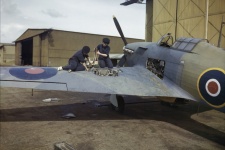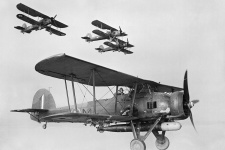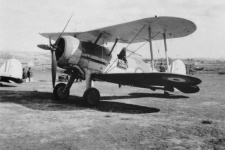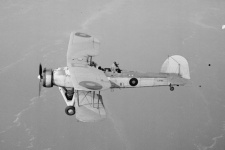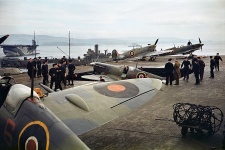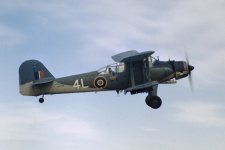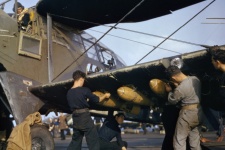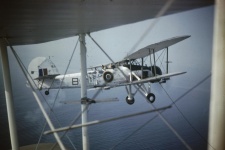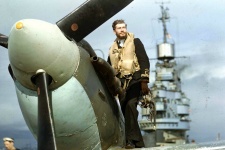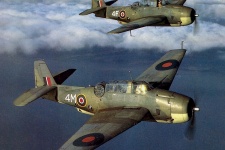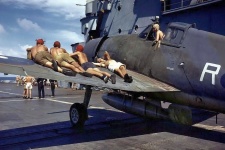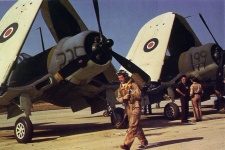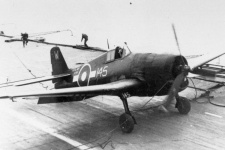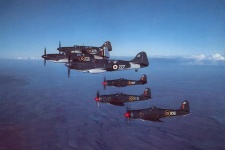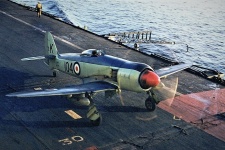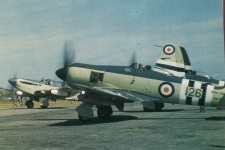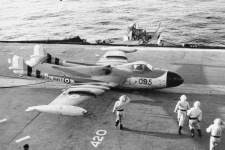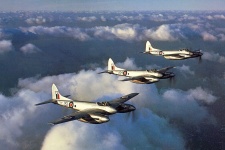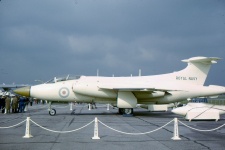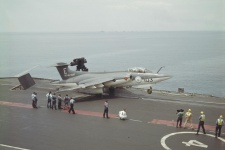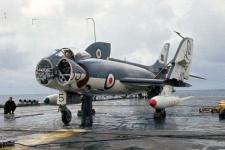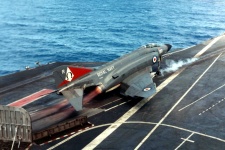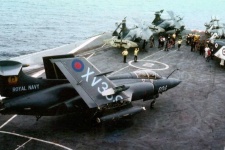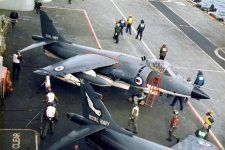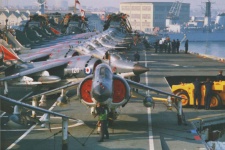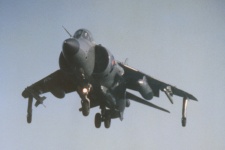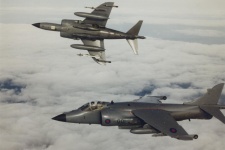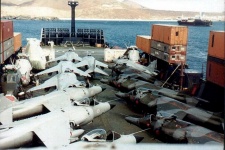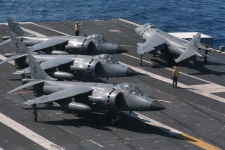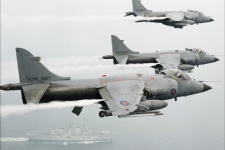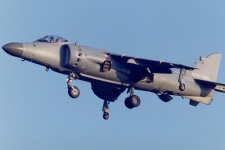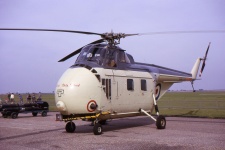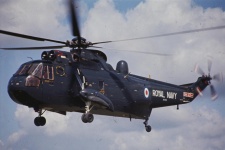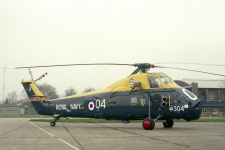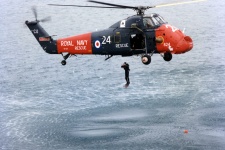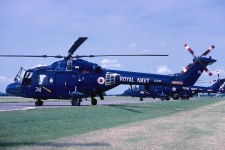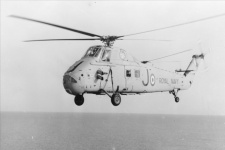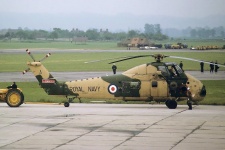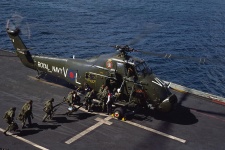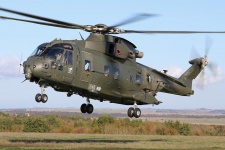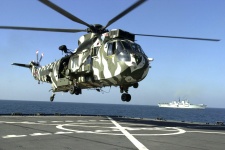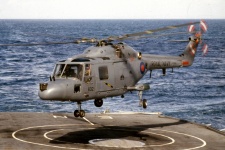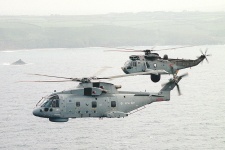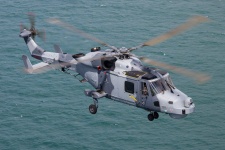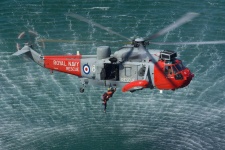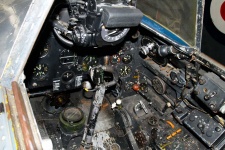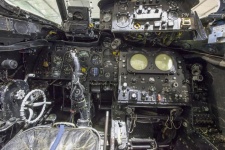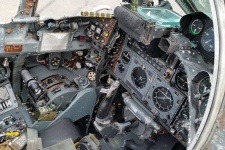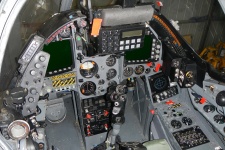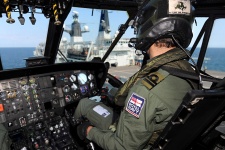Aircraft Colors and Camouflage, Royal Navy Fleet Air Arm
![]()
Introduction to British color standards
The main color standard used on British military aircraft is known as British Standard BS 381, which was was introduced in 1930 as British Standard BS 381: Colours for Ready Mixed Paints. It was revised shortly thereafter in 1931 as British Standard BS 381C. This included a total of 57 colors known by their one or two-digit numbers and which were ordered in the following manner: blues, browns, greens, grays, reds, browns, and yellows. Neither white nor black were included. A further seven colors were later added bringing the total palette to 64 colors by the start of World War II. A few numbers were skipped, resulting in the numbering running from 1 to 73 with six of the seven newer colors not following the standard color order.
Numerous new colors were developed in the years before World War II while others were introduced after the war had started. From 1940, the Ministry of Aircraft Production (MAP) took charge of wartime color standards and this included all the major colors used on Royal Air Force (RAF) and Fleet Air Arm (FAA) aircraft. There were also two wartime updates of BS 381C (1943 and 1944) with a reduced palette of only 27 colors. However, only a handful of BS 381C colors were ever used for aircraft camouflage purposes. MAP colors did not have any numerical designation and were simply known by their names. Camouflage schemes were specified through numerous Air Ministry or Admiralty orders and were usually based around named two-tone disruptive schemes (such as the Temperate Sea Scheme) plus an underside color, and determined by aircraft role. US aircraft provided to the RAF/FAA via Lend-Lease were typically factory-painted in DuPont colors that closely approximated their MAP originals, and later in substitute paints from the ANA system.
A major new revision BS 381C took place in 1948, from which it was known as BS 381C: Colours for Specific Purposes which was expanded to 91 colors. A new three-digit numbering system was introduced where the first digit refereed to the color and last two two digits the shade. Color digits are: blue (1), green (2), yellow (3), brown (4), red (5), gray (6), and violet (7). Notably, no whites are included. Thankfully, almost all colors from the 1931 palette transfered their number to the last two digits so for example, No 1 Sky Blue became Sky Blue BS 101 and No 62 Middle Stone became Middle Stone BS 362. There were very few exceptions, such as No 43 Salmon Pink redesignated Salmon Pink BS 447 and some name changes like No 7 Dark Blue renamed Strong Blue BS 107. Most of the relevant MAP wartime colors were later incorporated into the 1964 update with 102 colors, which was described as 'for identification or other technical purposes, or for purposes based on long established practice', although there were some notable omissions such as Ocean Grey. The MAP palette was discontinued following this update. Further updates to BS 381C took place in 1980 (66 colors, plus 41 that were designated as obsolete), 1988 (84), and 1996 (91) and after the latter, all colors have been specified as being semi-matt. A different standard, BS 4800: Paint Colours for Building Purposes has occasionally been used on aircraft as well with some colors like Barley Grey and Hemp eventually incorporated into BS 381C.
Contents:
- World War II
- Modern
- Post-War / Korean War / Suez Crisis (1945-56)
- Cold War (1957-1982)
- Falklands War (1982)
- Sea Harriers (1983-2006)
- Helicopters
- Cold War Helicopters (1957-82)
- Commando Helicopters (1957-Current)
- Modern Helicopters (1983-Current)
- Other
External Links:
- BSC 381C Colour Chart (1931)
- British Standard BS 381C Colour Chart
- Other BS Colours
- Imperial War Museum Collections Online
- Aircraft of the R.A.F. and S.A.A.F. during World War II in Colour (Etienne du Plessis)
References:
- Tanner, John (ed.), British Aviation Colours of World War Two, Arms and Armour Press (1976)
Paint guide basics:
All colors in this page include a paint chart with matches or equivalences from 19 different model paint ranges. Paints are considered matches if they are labeled with the intended color (either uniquely on together with another color). Paints are considered equivalences if they are close to the intended color but not labeled as such. The accuracy of any paint is independent of whether it is a match or an equivalence and these are described in the text (there can be poor matches and highly accurate equivalences). The following nomenclature is used in the paint tables and is based on matches or equivalences to US Insignia Red FS 11136:
| Paint | Match or equivalence type (label) |
| MP01 | Labeled to match one specific color (FS 11136) |
| MP02* | Labeled to match more than one color of same-country standards (FS 11136 / ANA 509)* |
| MP03** | Labeled to match more than one color of different-country standards (FS 11136 / BS 538) |
| MP04 (!) | Questionable accuracy of label match (doesn't look like FS 11136) |
| MP05 (?) | Questionable accuracy of label match, untested (doesn't look like FS 11136 in the bottle) |
| (MP06) | Close equivalent to FS 11136 (BS 538) |
| (MP07) (?) | Questionable equivalent to FS 11136 (Generic Gloss Red) |
* A single asterisk also denotes implicit matches for same-country standards where there is an official succession between standards. For example, H327* would match ANA 509 even if the label only references FS 11136 since ANA 509 is its official predecessor. This does not apply when there are considerable differences between successive paints (ex: Olive Drab No. 41/ANA 613/FS 34087) and this will be described in the text. By and large, however, single asterisk matches should be considered close enough to unique matches as to not be seriously questioned.
The paint charts make no distinction between gloss, semi-gloss, and matt variants of a color if the correct sheen is unavailable (ex: gloss FS 11136 will be a specific match for matt FS 31136 if the latter does not exist in the same paint range). Exceptions are made where there is a known or suspected color difference (ex: FS 24087 and 34087).
![]()
WORLD WAR II
Temperate Sea Scheme (1939-41)
The Fleet Air Arm shared shared similar camouflage schemes to those of RAF Coastal Command throughout World War II. At the start of the war, FAA aircraft were painted with a topside disruptive scheme known as the Temperate Sea Scheme (TSS) which was fitting for the dreary, overcast skies over the North Sea and the Atlantic even though it was used in tropical regions like the Mediterranean and Southeast Asia as well. he TSS was composed of Dark Slate Grey and Extra Dark Sea Grey. Dark Slate Gray is a dark olive gray, which much like US Olive Drab (which it closely resembles), had a tendency to look more green or more brown depending on lighting, fading, and wear. Extra Dark Sea Grey is a cool dark gray, with subtle hints of blue that were more pronounced with fading. The topside TSS camouflage pattern was of the same general style as its contemporary, the Temperate Land Scheme (as well as all other wartime patterns). Initially, the underside color that was paired with the Temperate Sea Scheme was Sky Grey, a light gray that was exclusive to FAA/Coastal Command aircraft.
At the start of the war, the FAA continued to employ a large number of biplanes, notably the Swordfish which despite being obsolete became arguably the most famous British-built naval aircraft of the war. Like the RAF, the FAA employed a camouflage technique known as 'shadow compensation' for its biplanes, which involved lower wings being painted in lighter colors than the standard scheme. The intention for this was that the shadow of the upper wings would even out the colors. Shadow compensation for the Temperate Sea Scheme consisted of Light Slate Grey and Dark Sea Grey. Light Slate Grey is a green-grey, that does not have the brownish hue of its darker counterpart. Dark Sea Grey was used more widely in the post-war period. It is somewhat similar to the 'mixed grey' used as a replacement for Ocean Grey in the Day Fighter Scheme, being roughy similar in brightness but with much less blue. There is greater contrast between these two colors than there is with the upper wing camo. Although the RAF abandoned shadow compensation early on in the war, it remained in use with the FAA for much longer, and was still being specified on naval aircraft as late as on 7 September 1944 (AMO A.864/44).
The demarcation line between the topside and underside colors varied among aircraft and among squadrons using the same aircraft. In the early years, it was more common to have demarcation at around the mid-point of the fuselage from top to bottom. Some aircraft used straight demarcations whereas in others it was somewhat irregular (this would be even more pronounced when temporary distemper paints were used as described in the following section). Blackburn aircraft (including Blackburn-built notably had the demarcation curve into the lower wing roots.
A few exceptions to the underside color were permitted, notably on reconnaissance aircraft in the Mediterranean which from mid-1940 onward were allowed to use Sky Blue, a color more suitable for the sunnier Mediterranean skies. Following the introduction of Azure Blue in 1941, this too became an optional color in theater. Due to their limited use on FAA aircraft, these colors are not described in greater detail here (see the RAF page instead).
Paint guide:
- Dark Slate Grey: Notably absent from the Gunze range but their greenish interpretation of RLM 81 (H421/C421) is a possible substitute. Otherwise, one could get away with using Olive Drab (preferably the later, browner ANA 613) and it's not surprising why it was the official US equivalent on Lend-Lease aircraft. Aside from Gunze, it is well represented.
- Extra Dark Sea Grey: EDSG is hard to get wrong, and approximates the US FS 36118 although less blue. All ranges that carry Dark Slate Grey carry EDSG which is convenient, with the added bonus that it is also available in the Gunze range. Most match the post-war version (BS 640) which was virtually identical to the wartime shade.
- Light Slate Grey: A few of the more modern ranges carry this color, though only Vallejo does among the traditional ones. Its closest equivalents from major Western palettes isSAC Bomber Green (FS 34159) or German Field Gray (RAL 7009).
- Dark Sea Grey: DSG is very well represented given its widespread post-war use. Despite its relative rarity in wartime service, Gunze offers a specific wartime version (H75/C25) which makes the omission of more widely used colors like Ocean Grey and Dark Slate Grey all the more puzzling. All references to the post-war version will refer to H331/C331. Like its extra dark counterpart (EDSG), there are very little differences between the wartime and post-war shades and it can also be an effective substite for Mixed Grey given that it has less blue than Ocean Grey but is of similar brightness.
- Sky Grey: Although poorly represented, it is generic enough that most paints labelled as such will suffice. Most of these match FS 36473 although it is believed that FS 36373 is a better choice. Tamiya XF-19 is close in terms of hue but noticeably dark. Only AK Real Color, Hataka, and Lifecolor make explicit reference to a UK color, while Vallejo suggests so by including 71.407 in its Coastal Command/FAA set.
| Sky Grey | Light Slate Grey | Dark Sea Grey | Dark Slate Grey | Extra Dark Sea Grey | |
| Schemes | |||||
| Biplane | Lower | Lower wing | Lower wing | Upper camo | Upper camo |
| Monoplane | Lower | Upper camo | Upper camo | ||
| Color matches | |||||
| Gunze Aqueous | - | - | H75 | - | H333 |
| Gunze Mr. Color | - | - | C25 | - | C333 |
| Humbrol | - | (31) | 164 | 224 | 123 |
| Model Master | - | - | 2059 | 2056 | 2059 |
| Revell | - | - | - | - | - |
| Tamiya | XF-19 | - | XF-54 | - | - |
| Vallejo Model Air | 71.407** | 71.406 | - | 71.309 | 71.110 |
| Vallejo Model Color | (70.989) | - | 70.991** | - | - |
| AKAN | - | 70018 | 70017 | 70046 | 70019 |
| AK Interactive | - | - | - | - | - |
| AK Real Color | RC285** | - | RC296 | RC294 | RC295 |
| AMMO by Mig | - | - | - | - | - |
| Colourcoats | ACRN13 | ACRN05 | ACRN03 | ACRN06 | ACRN02 |
| Hataka | HTK-_203** | - | HTK-_140 | HTK-_202 | HTK-_140 |
| Lifecolor | UA 521** | - | UA 108** | - | - |
| Mission Models | - | - | - | - | - |
| Mr. Paint | (MRP-242) | MRP-116 | MRP-113 | MRP-117 | MRP-114 |
| Xtracolor | - | X037 | X004 | X025 | X005 |
| Xtracrylix | - | XA1037 | XA1004 | XA1025 | XA1005 |
Temperate Sea Scheme (1941-45)
The RAF introduced Sky Type S (herein referred to simply as Sky) as its main underside color on 11 August 1940 and it would soon find its way on FAA aircraft as well, with all naval aircraft having the new color specified as its underside color from 12 December 1940 (AMO A.926/40). But being a RAF priority paint, it only began being used on the FAA from March 1941 onward. There is some controversy over what the correct shade of Sky was used in the first few months of its introduction (see RAF page) but it was the color that would later be classified as Sky BS 210 in the 1948 BSC 381C standard, a pale green-gray which also tends to lean towards yellow. It was also frequently referred to as 'duck egg blue'. As far as the topside, there was no change in FAA camouflage which retained the Temperate Sea Scheme of Dark Slate Grey and Extra Dark Sea Grey until the end of the war; unlike Coastal Command, FAA never adopted a single-tone topside of EDSG. As mentioned in the previous section, the use of Shadow Compensation of Light Slate Grey and Dark Sea Grey on biplane lower wings persisted until the end of the war as well, even though by the mid-war period only the Swordfish remained as a major FAA biplane.
The use of distemper (temporary) paint was also frequently employed by the FAA for special operations. For night operations, this involved (matt) black distemper (stores reference 33B/359) for the undersides, which was specified from 27 February 1941 (CAFO 460) and often with a demarcation line high in the fuselage sides. It was seen well before that date, as evidenced by some Swordfish aircraft during the November 1940 strike on Taranto with black undersides. For anti-submarine work, the color used was (matt) white distemper which was similarly applied to all undersides and often, large sections of the fuselage (sometimes leaving just a small strip of Temperate Sea Scheme at the top). The use of white distemper was commonplace on aircraft operating from MAC (Merchant Aircraft Carrier) ships as well as other anti-submarine work in the Atlantic, and most commonly seen on Swordfish Mk II and IIIs.
There were two distinct patterns that defined the demarcation between topside and underside colors. Pattern 1 had the demarcation line at the point that was parallel to a 60 degree angle from the ground. This meant that most of the fuselage sides would be painted in the topside colors. Pattern 2 had the demarcation line that was one-fourth from the top of the fuselage. This meant that most of the fuselage sides would be painted in the underside color. Most FAA fighters during the war would use Pattern 1, whereas aircraft using the distemper schemes would use Pattern 2 more frequently.
Paint guide:
- Sky Type S: Most paint ranges that carry just one Sky color will represent Sky Type S / Sky BS 210 and the wartime and post-war shades are close enough as to not make a major difference. It is my belief that Gunze H74/C26, which is labeled Sky (Duck Egg Green), is too saturated for Sky and more appropriate for Eau-de-Nil. However, it's newer C369 paint is correctly matched to BS 210. Humbrol's version of Sky is labeled Beige Green (90) and it has been noted that their shades have changed over the years. Tamiya also includes a generically named Sky (XF-21) which seems a bit too green and too dark.
- Black distemper: Black distemper should not be confused with Night, the color used on RAF undersides and which had a hint of blue due to its use of ultramarine pigments. Nevertheless, any matt black is acceptable.
- White Distemper: Basic matt white matches are included here, though Hataka (HTK-_153) is the only range to include a specific temporary white paint.
Links:
- Black undersides on FAA monoplanes - any ideas? (Britmodeller)
| Sky | Black Distemper | White Distemper | Dark Slate Grey | Extra Dark Sea Grey | |
| Schemes | |||||
| General | Lower | Upper camo | Upper camo | ||
| Night | Lower | Upper camo | Upper camo | ||
| Anti-Sub | Lower | Upper camo | Upper camo | ||
| Color matches | |||||
| Gunze Aqueous | H74 (!) | H12 | H11 | - | H333 |
| Gunze Mr. Color | C26 (!) / C368 | C33 | C62 | - | C333 |
| Humbrol | 90 | 33 | 34 | 224 | 123 |
| Model Master | 2049 | 1749 | 2142 | 2056 | 2059 |
| Revell | 159 | 04 | 05 | - | - |
| Tamiya | XF-21 | XF-1 | XF-2 | - | - |
| Vallejo Model Air | 71.302 | 71.057 | 71.001 | 71.309 | 71.110 |
| Vallejo Model Color | - | 70.950 | 70.842 | - | - |
| AKAN | 70005 | 78005 | 78002 | 70046 | 70019 |
| AK Interactive | AK 2015 | AK 735 | AK 738 | - | - |
| AK Real Color | RC290 | RC001 | RC004 | RC294 | RC295 |
| AMMO by Mig | A.MIG-243 | A.MIG-046 | A.MIG-050 | - | - |
| Colourcoats | ACRN01 | C02 | C03 | ACRN06 | ACRN02 |
| Hataka | HTK-_026 | HTK-041 | HTK-_153 | HTK-_202 | HTK-_140 |
| Lifecolor | UA 095** | LC 02 | LC 01 | - | - |
| Mission Models | MRP-080 | MMP-047 | MMP-001 | - | - |
| Mr. Paint | MRP-118 | MRP-171 | MRP-4 | MRP-117 | MRP-114 |
| Xtracolor | X007 | X012 | X405 | X025 | X005 |
| Xtracrylix | XA1007 | XA1012 | - | XA1025 | XA1005 |
Lend-Lease (1941-45)
The FAA struggled to produce carrier-based aircraft of equivalent quality to that of the other two main carrier powers, the US and Japan. Consequently, it relied extensively on US aircraft provided via Lend-Lease from 11 March 1941. Until 1944, Lend-Lease aircraft were typically factory painted in the US to FAA standards. Initially this meant using US equivalent paints to the three main FAA colors. These included, with their DuPont numbers in parenthesis: Dark Slate Grey (71-19323), Extra Dark Sea Grey (71-19324), and Sky (71-021). Of these, the first two topside colors were very close to their FAA versions with 71-19324 being slightly bluer. However, 71-021 was lighter and more saturated, being closer to FS 35622 which is also known as 'Duck Egg Blue'. A more thorough description of the differences between 71-021 and Sky Type S can be found in the Lend-Lease section of the RAF World War II page.
From 1942, the there was an attempt to coordinate aeronautical colors between the US's two main services (the USAAF and US Navy) as well as with the Ministry of Aircraft Production (MAP) in the UK. This resulted in the Army-Navy Aeronautical (ANA) system that was officially implemented from 28 September 1943. Along with the new system came the decision to use ANA substitutes for all Lend-Lease aircraft. For the undersides, the new palette included Sky ANA 610 which was much closer to the original compared to the earlier DuPont color (and closer still to the more yellow-gray post-war version). There were no ANA versions of Dark Slate Grey or EDSG and instead Olive Drab ANA 613 and Sea Grey ANA 603 were used respectively. Ironically, these two colors were also used as substitutes for the RAF Day Fighter Scheme although they are far closer to their Temperate Sea Scheme colors, with ANA 613 being slightly browner (but roughly similar brightness) while ANA 603 is slightly lighter than a freshly painted EDSG.
A final change took place in early 1945 when it was determined that Lend-Lease aircraft were to be left in their factory Glossy Sea Blue ANA 623 overall color. This was the only time a US camouflage scheme was used on a FAA aircraft. Aircraft that were seen in GSB included the Wildcat Mk VI (FM-2), Hellcat Mk II (F6F-5), and late versions of the Corsair.
Notably, Grumman avoided the use of ANA substitute colors on all their aircraft, maintaining the practice of using DuPont equivalents. Major Grumman aircraft used by the FAA included the Martlet/Wildcat (F4F), Hellcat (F6F), and Tarpon/Avenger (TBF) although the Eastern Aircraft-built versions of the Wildcat (FM) and Avenger (TBM) used ANA substitute paints. Notably, Grumman's Sky color is much closer to Sky Type S which suggests that DuPont 71-021 was not used for this particular color. Given Grumman's large share of early FAA Lend-Lease aircraft, it was probably not used much with the FAA at all.
A comparison between US and FAA paints is provided below with the disclaimer that hex equivalents will never be fully accurate to an original paint chip.
| FAA | DuPont | FS | FAA | ANA | FS | ||
| Sky | Sky | ||||||
| 71-021 | 35622 | ANA 610 | 34424 | ||||
| Dark Slate Grey | Dark Slate Grey | ||||||
| 71-19323 | 34096 | ANA 613 | 33077 | ||||
| Extra Dark Sea Grey | Extra Dark Sea Grey | ||||||
| 71-19324 | 36099 | ANA 603 | 36118 |
Paint guide:
- Sky ANA 610: The ANA color is much closer to the original Sky Type S and is matched to the post-war FS 34424. As a result, late war Lend-Lease aircraft (mostly FAA and RAF Coastal Command) can get away with using the RAF original (see Fleet Air Arm page). Hataka is the only range to carry a specific ANA 610 paint (HTK-_234) that is different from its Sky Type S paint (HTK-_026), while Model Master (2049) and Mission Models (MMP-080) are the only ones to include ANA 610 in their labels for Sky Type S. Confusingly, Vallejo has different paints for Sky Type S (71.302) and FS 34424 (71.103) when these should be nearly identical. All matches to either RAF Sky Type S or FS 34424 are taken as close equivalents in parenthesis. For a paint guide of the earlier Sky 72-021, see the Lend-Lease section on the RAF page.
- Olive Drab ANA 613: There is still debate over the differences between ANA 613 and the older OD 41 but it is believed that the ANA version was slightly lighter and browner. Although FS matches vary, it is my belief that the closest one is FS 33070 which would be consistent with the fact that ANA 613 is a Munsell yellow. Gunze H52/C12, although simply specified as a USAAF color, is closer to ANA 613 than OD 41. Likewise, Humbrol 155 is browner than 66, both of which are simply labeled as Olive Drab.
- Sea Grey ANA 603: The close association between ANA 603 and FS 36118 has led to the myth that it was just as blue where in fact it was much closer to neutral than the post-war color, and is probably closer to a faded Extra Dark Sea Grey. There is no specific match to ANA 603 in any paint range although FS 36118 is taken as a close equivalent in parenthesis.
- Glossy Sea Blue ANA 623: Gunze's Midnight Blue (H55/C71) is a very good match for ANA 623 despite the odd name, but being that it is specifically referenced to as a WW2 USN paint it is clear this was their intended match. C365 is also available from a USN set and is also matched to FS 15042 but I have not tested it to see if it is significantly different. Other than that, paint ranges with separate Sea Blue and Dark Sea Blue colors are considered ANA 607 and ANA 623 respectively and the latter are included here.
Links:
- Fleet Air Arm Colours (Key.Aero)
| ANA 610 | ANA 613 | ANA 603 | ANA 623 | |
| Sky | Olive Drab | Sea Gray | Glossy Sea Blue | |
| Schemes | ||||
| General (1941-43) | Upper | Lower | ||
| General (1943-45) | Lower | Upper | Lower | Overall |
| Alt (1945) | Overall | |||
| Color matches | ||||
| Gunze Aqueous | - | H52 | - | H55 |
| Gunze Mr. Color | (C368) | C12 | - | C71 / C365* |
| Humbrol | (90) | (155) | (125) | 181* |
| Model Master | 2049** | 2050 | (1723) | 1717* |
| Revell | (159) | - | (74) | - |
| Tamiya | - | - | (XF-24) | XF-17 (!) |
| Vallejo Model Air | (71.302) | 71.016* | 71.097* | 71.300* |
| Vallejo Model Color | - | 70.887* | (70.868) | (70.898) |
| AKAN | (70005) | 72033 | 72040* | (72042) |
| AK Interactive | (AK 2015) | AK 2204 | (AK 2144) | AK 2234 |
| AK Real Color | (RC290) | - | (RC244) | RC258 |
| AMMO by Mig | - | A.MIG-240* | (A.MIG-204) | (A.MIG-227) |
| Colourcoats | (ACRN01) | - | (ACUS14) | ANA623 |
| Hataka | HTK-_234* | HTK-_018 | HTK-_031* | HTK-_001* |
| Lifecolor | (UA 095) | - | (UA 022) | UA 047* |
| Mission Models | MMP-080** | - | (MMP-084) | MMP-065* |
| Mr. Paint | (MRP-118) | MRP-138 | (MRP-40) | MRP-14 |
| Xtracolor | (X007) | X113 | (X130) | X121* |
| Xtracrylix | (XA1007) | XA1113 | (XA130) | XA1121* |
![]()
MODERN
Post-War / Korean War / Suez Crisis (1945-56)
The most important change to FAA camouflage in the immediate post-war period was the abandonment of Dark Slate Grey, something that had taken taken place on Coastal Command aircraft since around 1943. This left FAA aircraft with a single-tone topside of Extra Dark Sea Grey BS 640 (the new three-digit BS system was introduced in 1948) and an underside of Sky BS 210. The new BS system made slight changes to the wartime colors but in most cases, they were sufficiently similar to look nearly identical, as was the case with EDSG. However, Sky was known to have changed more noticeably, being slightly yellower than its wartime predecessor. Another difference was the more widespread use of Pattern 2 across all types of FAA aircraft, probably because the use of EDSG as the sole topside color made aircraft look too dark. By the time of the Korean War the grand majority of FAA aircraft used Pattern 2.
A brief exception of the rule was the Sea Hornet night fighter, which had a brief and uneventful career in the FAA in the late 1940s and early 1950s. Following RAF tradition at the time, a small number of Sea Hornets were left in overall aluminium finish. Most Sea Hornets, however, used standard EDSG/Sky camouflage.
Following D-Day tradition, it was common for many FAA and Royal Australian Navy (RAN) aircraft to sport some kind of 'invasion stripe' style markings during the Korean War and the Suez Crisis. In the former, these consisted of three white and two black stripes that were nearly identical to those used on D-Day, painted on the wings and rear fuselage. FAA and Aéronavale aircraft participating in the Suez Crisis had three yellow and two black stripes, 12-inches wide for single-engined aircraft and 24-inches wide for multi-engined aircraft.
Paint guide:
- Extra Dark Sea Grey BS 640: Virtually identical to the wartime shade.
- Sky BS 210: The post-war version of Sky is close enough to the wartime version as to not present much of a problem for most modelers. Paints that show a more yellow-gray hue are preferred to those that are greener (like Gunze H74/C26 and Tamiya XF-21).
| BS 210 | BS 640 | |
| Sky | Extra Dark Sea Grey | |
| Schemes | ||
| General | Lower | Upper |
| Color matches | ||
| Gunze Aqueous | H74 (!) | H333 |
| Gunze Mr. Color | C26 (!) / C368 | C333 |
| Humbrol | 90 | 123 |
| Model Master | 2049 | 2059 |
| Revell | 159 | - |
| Tamiya | XF-21 | - |
| Vallejo Model Air | 71.302 | 71.110 |
| Vallejo Model Color | - | - |
| AKAN | 70005 | 70019 |
| AK Interactive | AK 2015 | - |
| AK Real Color | RC290 | RC295 |
| AMMO by Mig | A.MIG-243 | - |
| Colourcoats | ACRN01 | ACRN02 |
| Hataka | HTK-_026 | HTK-_140 |
| Lifecolor | UA 095** | - |
| Mission Models | MRP-080 | - |
| Mr. Paint | MRP-118 | MRP-114 |
| Xtracolor | X007 | X005 |
| Xtracrylix | XA1007 | XA1005 |
Cold War (1957-1982)
The introduction of anti-flash white paint on the RAF's V-Bombers in 1957 coincided with a switch to white undersides on FAA aircraft. This had also been adopted by the US Navy since white undersides where seen as ideal of protection against the flash of nuclear weapons if dropped. As a result, most new aircraft that began entering service after the Suez Crisis retained their Extra Dark Sea Grey BS 640 topsides but replaced the previously ubiquitous Sky with white undersides. A special white paint known as Anti-Flash White was later introduced on the Buccaneer (1962), having previously been used on the RAF's nuclear V-Bombers. This was designed to reflect the thermal blast of nuclear weapons, and was also paired with distinctive pale roundels and markings.
It is unclear whether there were any particular characteristics of Anti-Flash White that enhanced its thermal reflection properties or whether the name simply referred to its purpose (as this author suspects). All FAA aircraft that had nuclear weapons capability during this period like the Scimitar, Sea Vixen, Phantom, and Sea Harrier used white undersides and these appear indistinguishable from those on the Buccaneer, which is the only aircraft to definitively have used Anti-Flash White (tellingly, it was also the only one to use pale roundels). Anti-Flash White has also been matched to BS 00E55 from the BS 4800 palette which is also the most quoted match for the standard white on RAF/FAA aircraft, a color that has never been included in any edition of BS 381C. Aside from the aircraft mentioned above, older designs like the Sea Hawk transitioned to white undersides briefly before being phased out by the late 1950s/early 1960s. Other aircraft, like the anti-submarine Gannet, retained Sky as an underside color which further reinforces the point of all white undersides being used for nuclear thermal blast protection (the same reason the US Navy also switched to white undersides during this period).
Pattern 2 remained the predominant demarcation style on aircraft during this period until the introduction of the Phantom in 1968, where it reverted to a demarcation similar to the older Pattern 1. Around the time that the Phantom was introduced, the Buccaneer also changed to an overall-EDSG scheme which persisted until the retiring of the Royal Navy's carrier fleet in 1978 and the transfer of its carrier-based aircraft to the RAF. Around the same time, the Sea Harrier was introduced using EDSG/White. By now most aircraft carried nose-mounted radars and consequently, it was also common to have radomes painted in Night BS 642.
Paint guide:
- White: There has never been any white color specified in BS 381C, and there are four separate whites in BS 4800 of which the most likely match is BS 00E55. References are found to BS 302 Identification White at BS 802 White but neither of these colors have ever appeared on an BS 381C palette (although the latter is believed to exist commercially). In practice, however, the white used on RAF/FAA aircraft tends to yellow with age and look like an off-white similar to Insignia White FS 17875. As a result, matches to the latter are probably preferred for any model (see any of the US pages for references). The paint chart includes only matches to basic white.
- Anti-Flash White: Colourcoats (ARCN37) and Hataka (HTK-_322) are the only ranges to offer a specific RAF Anti-Flash White. There does not appear to be any discernible difference with the standard white used on RAF/FAA aircraft. Matches to generic off-whites are included as close equivalents in parenthesis in the event that the modeler prefers a slightly tinted white instead.
| BS 640 | |||
| White | Anti-Flash White | Extra Dark Sea Grey | |
| Schemes | |||
| General | Lower | Upper | |
| Buccaneer (Early) | Overall | ||
| Buccaneer (Late) | Overall | ||
| Color matches | |||
| Gunze Aqueous | H11 | (H21) | H333 |
| Gunze Mr. Color | C62 | (C69) | C333 |
| Humbrol | 34 | - | 123 |
| Model Master | 2142 | - | 2059 |
| Revell | 05 | - | - |
| Tamiya | XF-2 | - | - |
| Vallejo Model Air | 71.001 | - | 71.110 |
| Vallejo Model Color | 70.842 | (70.820) | - |
| AKAN | 78002 | (73146) | 70019 |
| AK Interactive | AK 738 | - | - |
| AK Real Color | RC004 | (RC-013) | RC295 |
| AMMO by Mig | A.MIG-050 | - | - |
| Colourcoats | C03 | ACRN37 | ACRN02 |
| Hataka | HTK-_101 | HTK-322 | HTK-_140 |
| Lifecolor | LC 01 | - | - |
| Mission Models | MMP-001 | - | - |
| Mr. Paint | MRP-4 | - | MRP-114 |
| Xtracolor | X405 | - | X005 |
| Xtracrylix | - | - | XA1005 |
Falklands War (1982)
The FAA's new Sea Harrier force was quickly thrown into combat during the 1982 Falklands War, where it became the Royal Navy's main fleet defense aircraft. The Sea Harrier force was initially deployed its standard peacetime colors and large, colorful squadron markings. However, they were repainted en route to the Falklands in an overall Extra Dark Sea Grey BS 640 scheme along with lo-viz markings, a scheme that would award it its flattering nickname of 'Black Death' by Argentinean pilots. However, an exception to the rule was the hastily recreated 809 Naval Air Squadron, whose eight Sea Harriers were painted in overall Medium Sea Grey BS 637 with Camouflage Grey BS 626 (also known as Barley Grey') in the lower part of the wings and stabilizers (but not the fuselage). 809 NAS aircraft were also notable for having pale lo-viz roundels. Most Sea Harriers that were repainted for Falklands service remained in their wartime squadron colors through much of 1982, before new Sea Harrier scheme was standardized. As was common with most Cold War FAA aircraft, radomes were generally painted black.
Paint guide:
- Medium Sea Grey BS 640: Gunze's post-war representation H335/C335 is too blue for either the wartime or post-war version which were not fundamentally different. A newer version from a RAF paint set (C363) appears to be a better representation. Tamiya's version (XF-83) is a great match, while paints that are too dark to harmonize well with the wartime Day Fighter Scheme (like Xtracolor/Xtracrylix) may be more suitable for use in a non-disruptive scheme like this.
- Camouflage Grey BS 626: This is a widely-used modern RAF color though only available with Gunze and Humbrol among the traditional ranges. The contrast between BG and MSG is very subtle and should not appear too pronounced. Camouflage Grey is also a color found in the BS4800 palette where it is designated 18B21. In one of many cases of Vallejo re-labeling, 71.051 was originally labeled Barley Grey but is now Neutral Gray (FS 36173) and thus incorrect.
| BS 640 | BS 626 | BS 637 | |
| Extra Dark Sea Grey | Camouflage Grey | Medium Sea Grey | |
| Schemes | |||
| General | Overall | ||
| 809 NAS | Lower | Upper | |
| Color matches | |||
| Gunze Aqueous | H333 | H334 | H335 (!) |
| Gunze Mr. Color | C333 | C334 | C335 (!) / C363 |
| Humbrol | 123 | 167 | 165 |
| Model Master | 2059 | - | 2058 |
| Revell | - | - | - |
| Tamiya | - | - | XF-83 |
| Vallejo Model Air | 71.110 | - | 71.307 |
| Vallejo Model Color | - | - | 70.870** |
| AKAN | 70019 | - | 70016 |
| AK Interactive | - | - | AK 2013 |
| AK Real Color | RC295 | RC299 | RC289 |
| AMMO by Mig | - | A.MIG-207** | A.MIG-246 |
| Colourcoats | ACRN02 | ACRN04 | |
| Hataka | HTK-_140 | HTK-_142 | HTK-_034 |
| Lifecolor | - | UA 097 | UA 094** |
| Mission Models | - | - | MMP-094 |
| Mr. Paint | MRP-114 | - | MRP-112 |
| Xtracolor | X005 | X017 | X003 |
| Xtracrylix | XA1005 | XA1017 | XA1003 |
Sea Harriers (1983-2006)
After the Falklands War, the Sea Harrier fleet standardized its camouflage, switching to an overall scheme of Dark Sea Grey BS 638. This was widely used on RAF post-war aircraft although it had not seen much FAA service since World War II as shadow compensation on biplanes. This lasted throughout most of the time in service of the Sea Harrier FRS.1 as well as the introduction of the more advanced Sea Harrier FA.2 in 1993. A few years latter, a further revision took place which resulted in the Sea Harrier fleet being painted Medium Sea Grey BS 637, similar to those of 809 NAS during the Falklands War, albeit without the Barley Grey undersides. Additionally, radomes were painted Dark Sea Grey rather than the older black. This was the last scheme ever used on a Sea Harrier: they were retired from service in March 2006 leaving the FAA with no fixed-wing aircraft until the introduction of the US-built F-35 in 2020-22 (see the USAF page for description of F-35 colors).
Paint guide: All colors are described in previous sections.
| BS 638 | BS 637 | |
| Dark Sea Grey | Medium Sea Grey | |
| Schemes | ||
| General (1983-1995) | ||
| General (1995-2006) | Lower wing | Upper |
| Color matches | ||
| Gunze Aqueous | H331 | H335 (!) |
| Gunze Mr. Color | C331 | C335 (!) / C363 |
| Humbrol | 164 | 165 |
| Model Master | 2059 | 2058 |
| Revell | - | - |
| Tamiya | XF-54 | XF-83 |
| Vallejo Model Air | - | 71.307 |
| Vallejo Model Color | 70.991** | 70.870** |
| AKAN | 70017 | 70016 |
| AK Interactive | - | AK 2013 |
| AK Real Color | RC296 | RC289 |
| AMMO by Mig | - | A.MIG-246 |
| Colourcoats | ACRN03 | ACRN04 |
| Hataka | HTK-_140 | HTK-_034 |
| Lifecolor | UA 108** | UA 094** |
| Mission Models | - | MMP-094 |
| Mr. Paint | MRP-113 | MRP-112 |
| Xtracolor | X004 | X003 |
| Xtracrylix | XA1004 | XA1003 |
![]()
HELICOPTERS
Cold War Helicopters (1957-1990s)
Throughout the Cold War, the FAA's helicopter fleet was dominated by Sikorsky helicopters from the US, typically locally-produced and modified by Westland. Early helicopters like the Dragonfly (based on the S-48) and the Whirlwind (based on the S-55) were typically painted in standard FAA aircraft colors of Extra Dark Sea Grey BS 640 and Sky BS 210 although it was common to see Sikorsky-produced units left in their standard US factory colors (usually Glossy Sea Blue ANA 623 or their natural metal finish).
A unique FAA helicopter scheme was introduced in 1957 (AFO 2573/57) where it was determined to use RAF Blue Grey BS 633. This was a dark color, comparable to EDSG when freshly painted though noticeably more blue. Additionally, it was determined that helicopters employed on anti-submarine duties were to have their upper surfaces painted in Golden Yellow BS 356. This is a deep yellow and is also widely used on RAF rescue helicopters as well as trainers (hence its colloquial name of Trainer Yellow) although it is often believed that these are two separate colors. It is a descendant of the wartime Roundel Yellow although the post-war version was less orange than its predecessor. However, FAA search-and-rescue (SAR) helicopters used a different scheme, consisting of the nose and parts of the tail boom painted in various types of red. Originally, the color used was Day-Glo Red Orange (not on the BS 381C palette). This is a fluorescent color that is also known in the US as Fluorescent Red Orange (FS 28913). However, it is believed that this color changed over the years, with Signal Red BS 537 (also known as Red Arrows Red) and possibly Cherry Red BS 538 (also known as Post Office Red) also being used. Most SAR markings looked slightly lighter than the roundels (which match BS 538) which suggests BS 537 as being the more frequent of the two.
In the later years of the Cold War, there was a notable exception to the standard FAA helicopter scheme. Initial versions of the Lynx (HAS.2) were painted in overall Oxford Blue BS 105 in the late 1970s and early 1980s, before switching to the modern helicopter schemes described in the next section. This is one of the classic colors in the BS 381C palette and is closer to a basic navy blue. It is believed that some earlier FAA helicopters may have been painted in Oxford Blue although this is unverified and under certain lighting conditions the two colors may have appeared similar.
Paint guide:
- RAF Blue Grey BS 633: Despite its ubiquity on FAA helicopters, this color is poorly represented, mostly in enamel. Humbrol 79 is not specifically labeled to BS 633 and may just be a generic blue gray, which may be approximated to BS 633 with some darkening.
- Oxford Blue BS 105: Also not a very well represented color, although covered by the three main British-focused ranges (Humbrol, Colourcoats, and Xtracolor). Strangely, AKAN has this color only in its enamel and lacquer ranges, not in acrylic.
- Golden Yellow BS 356: There is confusion over whether Golden Yellow and Trainer Yellow are different colors (they are not). Xtracolor/Xtracrylix are the only ranges that have separate paints for each of which X019/X1019 is the only one matched to BS 356. Colourcoats (ACRN21) is simply labeled RAF/FAA Yellow and is most likely the wartime roundel color. All other matches are either for BS 356 or Trainer Yellow regardless of label.
- Day-Glo Red Orange: Only Hataka offers a match for Day-Glo Red (HTK-_268), while Humbrol labels its paint Fluorescent Fire Orange (209). Fortunately, this color matches FS 28913 as well as RAL 3024. These are included as close equivalents in parenthesis.
- Signal Red BS 537: This one is more widely available than BS 538 and most of the ranges that carry Golden Yellow BS 356 will carry this one. Vallejo (71.070) is labeled generically so may not be a good match. Colourcoats (ACRN21) is simply labeled RAF/FAA Red and is most likely the wartime roundel color. AK Real Colors (RC005) is matched to RAL 3020 but should be acceptable.
Links:
- RN/RAF Wessex colors (Britmodeller)
- Royal Navy Westland Whirlwind colours? (Britmodeller)
| BS 633 | BS 105 | BS 356 | BS 537 | ||
| RAF Blue Grey | Oxford Blue | Golden Yellow | Day-Glo Red Orange | Signal Red | |
| Schemes | |||||
| General | Overall | (Rescue) | (Rescue) | ||
| ASW | Overall | Upper | (Rescue) | (Rescue) | |
| Lynx (Early) | Overall | ||||
| Color matches | |||||
| Gunze Aqueous | - | - | - | - | - |
| Gunze Mr. Color | - | - | - | - | - |
| Humbrol | 79 (?) | 104 | 24 | 209 | 174 |
| Model Master | - | - | 2063 | (2041) | - |
| Revell | - | - | - | (332) | - |
| Tamiya | - | - | - | - | - |
| Vallejo Model Air | - | - | 71.078** | - | 71.070 (?) |
| Vallejo Model Color | - | 70.807 | - | - | - |
| AKAN | - | 6/80002 | 70009 | - | 70012 |
| AK Interactive | - | - | - | - | - |
| AK Real Color | - | - | - | - | (RC005) |
| AMMO by Mig | - | - | - | - | - |
| Colourcoats | ACRN19 | ACRN31 | - | - | - |
| Hataka | HTK-_145 | HTK-_292 | HTK-_275 | HTK-_268 | HTK-_276 |
| Lifecolor | - | - | - | - | - |
| Mission Models | - | - | - | - | - |
| Mr. Paint | MRP-380 | MRP-183 | - | (MRP-193) | MRP-184 |
| Xtracolor | X013 | X023 | X019 | (X161) | X014 |
| Xtracrylix | - | - | X1019 | - | X1014 |
Commando Helicopters (1957-Current)
The FAA is in charge of the Royal Navy's Commando helicopter force, which has mostly consisted in Wessex HU.5, Sea King HC.4, and more recently Merlin HC.3/4s. In contrast to other FAA helicopters, the Commando helicopter force is camouflaged for operations over land and therefore uses mostly Army colors. Initially this consisted of an overall scheme of Light Stone BS 361. This is a very common Army color which was used extensively on World War II as well as on modern desert vehicles, having a mustard-like tone when freshly painted but can also appear like a light tan. It was also a pre-war color from the original BS 381C palette, where it was numbered No. 61. Later, it became more common to use a two-tone disruptive scheme with Olive Drab BS 298. This is the post-war successor to the widely used Olive Drab SCC 15 used on late war (1944-45) tanks. Unlike US Olive Drabs which lean towards a brown hue, the BS version is unmistakably green. By the 1980s, it became increasingly common for Commando helicopters to be left entirely in overall Olive Drab BS 298. Additionally, Commando helicopters operating in Arctic territory are also painted in a tiger stripe scheme of Olive Drab BS 298 and white distemper.
Paint guide:
- Light Stone BS 361: Light Stone is widely available in most newer paint ranges as well as Model Master and Vallejo among the traditional ones. It is often labeled as British Gulf War Armor or Sand Yellow. Unfortunately, the hue can vary considerably, with many leaning towards tan and others towards yellow. Strangely, Xtracolor and Xtracrylix versions of BS 361 are labeled differently, with the former known as RAF Light Stone and the latter British Gulf Armour though both reference BS 361.
- Olive Drab BS 298: Unfortunately, only three ranges (AKAN, Hataka, and Xtracolor) have BS 298. Fortunately, BS 298 is believed to be close enough to the wartime SCC 15 that this should add numerous other options, and these are included as close equivalents in parenthesis. Hataka is the only range that includes a version of SCC 15 (HTK-_110) as well.
Links:
- RN/RAF Wessex colors (Britmodeller)
- Royal Navy Westland Whirlwind colours? (Britmodeller)
| BS 361 | BS 298 | ||
| Light Stone | Olive Drab | White Distemper | |
| Schemes | |||
| Early | Overall | ||
| Disruptive | Wrap camo | Wrap camo | |
| Late | Overall | ||
| Arctic | Wrap camo | Wrap camo | |
| Color matches | |||
| Gunze Aqueous | - | - | H11 |
| Gunze Mr. Color | - | - | C62 |
| Humbrol | - | - | 34 |
| Model Master | 2137 | - | 2142 |
| Revell | - | - | 05 |
| Tamiya | - | - | XF-2 |
| Vallejo Model Air | 71.143 | - | 71.001 |
| Vallejo Model Color | - | - | 70.842 |
| AKAN | 70026 | 70008 | 78002 |
| AK Interactive | AK 4034 | - | AK 738 |
| AK Real Color | RC040 | (RC037) | RC004 |
| AMMO by Mig | A.MIG-030 | (A.MIG-112) | A.MIG-050 |
| Colourcoats | ARB01 | (ARB19) | C03 |
| Hataka | HTK-_237 | HTK-_146 | HTK-_153 |
| Lifecolor | UA 225 | (UA 270) | LC 01 |
| Mission Models | MMP-044 | MMP-001 | |
| Mr. Paint | MRP-337 | (MRP-349) | MRP-4 |
| Xtracolor | X029 | X028 | X405 |
| Xtracrylix | XA1813 | - | - |
Modern Helicopters (1982-Current)
Around the time of the Falklands War came the introduction of the second naval variant of the Lynx helicopter, the HAS.3, which also coincided with a switch towards Medium Sea Gray BS 637 on all new non-Commando FAA helicopters. Existing aircraft largely retained their older colors but were gradually retired from ship-borne duties as the Lynx became more widely available. The Sea King also began replacing the Wessex in the SAR role where they also sported Signal Red BS 537 markings on the nose, pontoons, and tail booms. More recently, the introduction of the Wildcat (a major upgrade of the basic Lynx design) introduced a two-tone disruptive scheme, the first on a non-Commando FAA helicopter, consisting of Dark Sea Grey BS 638 over the Medium Sea Grey base.
Paint guide: All colors are described in previous sections.
| BS 637 | BS 638 | BS 537 | |
| Medium Sea Grey | Dark Sea Grey | Signal Red | |
| Schemes | |||
| General | Overall | (Rescue) | |
| Disruptive | Wrap camo | Wrap camo | |
| Color matches | |||
| Gunze Aqueous | H335 (!) | H331 | - |
| Gunze Mr. Color | C335 (!) / C363 | C331 | - |
| Humbrol | 165 | 164 | 174 |
| Model Master | 2058 | 2059 | - |
| Revell | - | - | - |
| Tamiya | XF-83 | XF-54 | - |
| Vallejo Model Air | 71.307 | - | 71.070 (?) |
| Vallejo Model Color | 70.870** | 70.991** | - |
| AKAN | 70016 | 70017 | 70012 |
| AK Interactive | AK 2013 | - | - |
| AK Real Color | RC289 | RC296 | - |
| AMMO by Mig | A.MIG-246 | - | - |
| Colourcoats | ACRN04 | ACRN03 | ACRN22 (?) |
| Hataka | HTK-_034 | HTK-_140 | HTK-_276 |
| Lifecolor | UA 094** | UA 108** | - |
| Mission Models | MMP-094 | - | - |
| Mr. Paint | MRP-112 | MRP-113 | MRP-184 |
| Xtracolor | X003 | X004 | X014 |
| Xtracrylix | XA1003 | XA1004 | X1014 |
![]()
OTHER
Cockpits (1948-Current)
Note: World War II cockpits are described in the RAF World War II page.
In the immediate post-war period, the majority of FAA aircraft had transitioned into all-black Night (from 1948, Night BS 642) cockpits although this was largely manufacturer-specific; a few aircraft like the Seafire still used the wartime Green Grey up until the final F.45/46/47 variants which used Night. In parallel with the move towards gray cockpits in other navies (notably the US Navy), the FAA eventually adopted Dark Admiralty Grey BS 632 as its main cockpit color beginning on the Buccaneer which entered service in 1962. Although they are often taken as broadly similar, BS 632 was noticeably darker than its US counterpart, Dark Gull Gray FS 36231, and also had a apparent bluish tone that is more evident in some photos than others. An exception to the rule was the Phantom, which being a US design retained its original FS 36231 cockpit color.
FAA helicopter colors have been mostly Night, which is particularly suitable for night vision goggle (NVG) compatibility. However, some mid-Cold War helicopters have used Dark Admiralty Grey, these being some Wessex and Sea Kings (not variant-specific) though in the latter case, DAG cockpits appear to be more common in export rather than FAA variants.
Paint guide:
- Night BS 642: For cockpit purposes, a basic black will suffice but preferably a black-gray in order to emphasize instrument panels.
- Dark Admiralty Grey BS 632: Dark Admiralty Grey does not have a better FS match than 36231 which is unfortunate, since it is in fact darker and bluer (possibly half-way towards FS 36173). Even more unfortunate is that this color is rare, with only Humbrol, AKAN, Colourcoats, and Xtracolor having matches (and AKAN being the only non-enamel).
| BS 642 | BS 632 | |
| Night | Dark Admiralty Grey | |
| Schemes | ||
| Early | Cockpit | |
| Late | Cockpit | |
| Color matches | ||
| Gunze Aqueous | (H77) | - |
| Gunze Mr. Color | C125 | - |
| Humbrol | - | 5 |
| Model Master | - | - |
| Revell | - | - |
| Tamiya | (XF-85) | - |
| Vallejo Model Air | (71.315) | - |
| Vallejo Model Color | (70.862) | - |
| AKAN | (79043) | 70057 |
| AK Interactive | AK 2066 | - |
| AK Real Color | (RC022) | - |
| AMMO by Mig | (A.MIG-033) | - |
| Colourcoats | (ACRN17) | NARN50 |
| Hataka | - | - |
| Lifecolor | - | - |
| Mission Models | MMP-108 | - |
| Mr. Paint | (MRP-255) | - |
| Xtracolor | X012 | X410 |
| Xtracrylix | XA1012 | - |
Interiors (1948-Current)
Note: World War II interiors are described in the RAF World War II page.
There does not appear to have been a standardized set of interior colors on FAA aircraft and in most cases, these were manufacturer- and aircraft-specific although there were some definitive trends throughout the post-war period. Early aircraft that used Sky BS 210 undersides typically painted their exposed interiors (wheel wells) and landing gear in Sky as well, although landing gear and wheel hubs would in some cases be left in their natural metal or perhaps an aluminum lacquer. One notable exception was Hawker, which used a proprietary yellow primer which is often believed to be Zinc Chromate although it is noticeably paler, the confusion probably stems from touch up work with Zinc Chromate on restored aircraft. It has mostly been seen on some wheel wells and wing folds of Sea Furies and some Sea Hawk aircraft as well. Around the time of the switch to white undersides, it became more common to see Light Admiralty Gray BS 697 on many wheel wells, wing folds, and landing gear (though not wheel caps which were typically left either natural metal or white). BS 697 has a distinctive blue-gray hue and is similar (though bluer) to the color used on modern Soviet/Russian wheel wells and landing gear. It has also sometimes been confused for Light Aircraft Grey BS 631 or Light Grey BS 631 although neither of the two have any perceptible blue. The last British-built FAA aircraft, the Sea Harrier, retained the Light Admiralty Grey landing gear but otherwise had white interior spaces, while the US-designed Phantom followed US practice and had all-white interiors.
The following chart summarizes the interior colors on major post-war RAF aircraft, with the caveats that not all aircraft of the same design may have had the same colors over their lifetimes and that restored aircraft that are used as guides for determining interior colors may not be fully accurate. A large selection of aircraft walkarounds can be found at Aircraft Resource Center, Britmodeller, and Prime Portal.
| Cockpit | Wells | Covers | Gear | Caps | |
| Seafire (XV,XVII) | |||||
| GG | Sky | Sky | Metal | Metal | |
| Seafire (45/46/47) | |||||
| Night | Sky | Sky | Metal | Metal | |
| Firefly | |||||
| Night | GG | Sky | Sky | Metal | |
| Sea Fury | |||||
| Night | Primer | Sky | Sky | Metal | |
| Sea Hornet | |||||
| BS 642 | Metal | Metal | Metal | Metal | |
| Attacker | |||||
| BS 642 | BS 283 | BS 210 | BS 210 | Metal | |
| Wyvern | |||||
| BS 642 | Metal | Metal | Metal | Metal | |
| Sea Venom | |||||
| BS 642 | BS 210 | BS 210 | Metal | Metal | |
| Sea Hawk | |||||
| BS 642 | BS 210 | BS 210 | BS 210 | Metal | |
| Scimitar | |||||
| BS 642 | Metal | Metal | Metal | Metal | |
| Sea Vixen | |||||
| BS 642 | BS 697 | BS 697 | BS 697 | Metal | |
| Buccaneer | |||||
| BS 632 | BS 697 | BS 697 | BS 697 | Metal | |
| Phantom | |||||
| FS 36231 | White | White | White | White | |
| Sea Harrier | |||||
| BS 632 | White | White | BS 697 | White |
| Cockpit | Bays | Wells | Covers | Gear | Caps | |
| Gannet | ||||||
| BS 642 | BS 642 | BS 697 | BS 210 | BS 210 | Metal | |
| Buccaneer | ||||||
| BS 632 | BS 697 | BS 697 | BS 697 | BS 697 | Metal |
Paint guide:
- Aircraft Gray Green BS 283: This superseded the wartime interior color and is described in the RAF interior section.
- Light Admiralty Grey BS 697: This is very poorly represented even among the British-focused ranges, among which only Colourcoats has it in its naval range, though matched to BS 687 (NARN51). Fortunately, it is very similar to a generic light sea gray insofar as it has a blueish hue, which is the case with both Tamiya (XF-25) and Vallejo (70.973).
| BS 210 | BS 283 | BS 697 | BS 00E55 | ||
| Aluminium | Sky | Aircraft Grey Green | Light Admiralty Gray | White | |
| Schemes | |||||
| Early | (Landing gear) | (Interior) / (Landing gear) | (Interior) | ||
| Mid | (Landing gear) | Interior / Landing gear | |||
| Late | Landing gear | Interior | |||
| Color matches | |||||
| Gunze Aqueous | (H8) | H74 (!) | - | - | H11 |
| Gunze Mr. Color | (C8) | C26 (!) / C368 | C364 | - | C62 |
| Humbrol | 56 | 90 | 78 | - | 34 |
| Model Master | 1781 | 2049 | 2062 | - | 2142 |
| Revell | 99 | 159 | - | - | 05 |
| Tamiya | XF-16 | XF-21 | - | (XF-23) | XF-2 |
| Vallejo Model Air | 71.062 | 71.302 | 71.126** | - | 71.001 |
| Vallejo Model Color | - | - | - | (70.973) | 70.842 |
| AKAN | 76004 | 70005 | 70007 | 70023 | 78002 |
| AK Interactive | - | AK 2015 | AK 2018 | - | AK 738 |
| AK Real Color | RC020 | RC290 | RC293 | - | RC004 |
| AMMO by Mig | A.MIG-194 | A.MIG-243 | A.MIG-219** | - | A.MIG-050 |
| Colourcoats | - | ACRN01 | ACRN28 | NARN51 | C03 |
| Hataka | HTK-_078 | HTK-_026 | HTK-_025 | HTK-_205 | HTK-_322 |
| Lifecolor | LC-74 | UA 095** | UA 551** | - | LC 01 |
| Mission Models | MMM-003 | MRP-080 | MMP-079 | - | MMP-001 |
| Mr. Paint | MRP-3 | MRP-118 | MRP-111 | MRP-379 | MRP-4 |
| Xtracolor | X142 | X007 | X010 | - | X405 |
| Xtracrylix | (XA1216) | XA1007 | XA1010 | - | - |
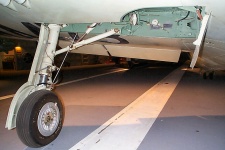 |
The Supermarine Attacker was an oddity in that it had Green Gray wheel wells, although the landing gear and covers were Sky. Most Cold War FAA aircraft had unpainted wheel caps. (Photo credit: Howard Mason via Prime Portal) |
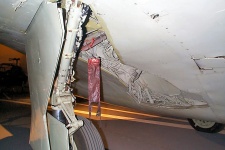 |
The Sea Hawk's wheel well and landing gear retain the underside Sky, although traces of what is likely Hawker yellow primer can be seen. (Photo credit: Howard Mason via Prime Portal) |
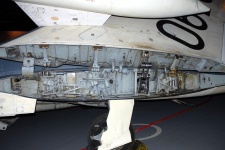 |
The wing fold of this Sea Vixen shows Light Admiralty Grey, which also colored its wheel wells and landing gear. |
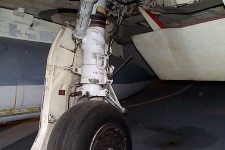 |
FAA Phantoms had US-style interiors and cockpits. This one may have had a different (or more recent) white paint for its landing gear than the heavily yellowed white seen around it. |
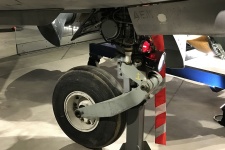 |
The landing gear on this Sea Harrier shows the unmistakable Light Admiralty Grey (not Light Aircraft Grey as sometimes believed). |
Color Tables
| BS 1948 | BS 1931 | DuPont | FED-STD* | Munsell** | ||
| Light Earth | - | - | 71-048 | FS 30257 | ? | |
| Dark Earth | BS 350 | - | 71-035 | FS 30118 | ? | |
| Light Green | - | - | 71-047 | FS 34172 | ? | |
| Dark Green | BS 241 | - | 71-013 | FS 34083 | 10Y 2.9/1.5 | |
| Extra Dark Sea Green | - | - | 71-067 | FS 34092 | ? | |
| Grey Green | BS 238 | - | 71-036 | FS 34226 | ? | |
| Medium Sea Grey | BS 637 | - | FS 36270 | ? | ||
| Dark Sea Grey | BS 638 | - | - | FS 36173 | ? | |
| Extra Dark Sea Grey | BS 640 | - | 71-19324 | FS 36099 | ? | |
| Ocean Grey | - | - | 71-068 | FS 36152 | 7B 4.5/1 | |
| Light Slate Grey | BS 639 | - | - | FS 34159 | ? | |
| Dark Slate Grey | BS 634 | - | 71-19323 | FS 34096 | 0.5GY 3.7/1 | |
| Sky Grey | - | - | - | FS 36463 | ? | |
| Sky | BS 210 | - | 71-021 | FS 34504 | ? | |
| Deep Sky | - | - | 71-052 | FS 35056 | ? | |
| Sky Blue | BS 101 | No 1 | 71-061 | FS 35550 | ? | |
| Azure Blue | BS 104 | No 4 | 71-062 | FS 35231 | 4.1PB 6.2/6.0 | |
| Light Mediterranean Blue | - | - | 71-063 | FS 35117 | 2.4PB 4.4/4.6 | |
| Dark Mediterranean Blue | - | - | 71-064 | FS 35109 | ? | |
| PRU Blue | BS 636 | - | 71-066 | FS 35164 | 5.3B 3.9/3 | |
| Middle Stone | BS 362 | No 62 | 71-069 | FS 30266 | ? | |
| Night | BS 642 | - | 71-006 | FS 37038 | ? | |
| Yellow | BS 356 | No 56 | 71-010 | FS 33538 | ? | |
| Red | - | - | - | FS 31105 | ? | |
| Blue | BS 110 | - | - | FS 35056 | ? | |
| Aluminum | - | - | - | - | ? | |
| Matt (Dull) Red | - | - | 71-007 | - | ? | |
| Matt (Dull) Blue | - | - | 71-012 | - | ? | |
| Semi Matt Black | - | - | - | - | ? | |
* Federal Standard numbers are approximate
** Munsell values quoted from Nick Millmann via Britmodeller. Hex values adapted from color plate in Tanner (1976).
| FED-STD* | ||||
| BS 105 | Oxford Blue | Camo (Lynx) | FS 35050 | |
| BS 210 | Sky | Camo (Post-war) | FS 34424 | |
| BS 283 | Aircraft Grey Green | Interiors | FS 34226 | |
| BS 298 | Olive Drab | Camo (Commando) | FS 34098 | |
| BS 356 | Golden Yellow | Camo (ASW) | FS 33538 | |
| BS 361 | Light Stone | Camo (Commando) | FS 33448 | |
| BS 537 | Signal Red | SAR Markings | FS 31350 | |
| BS 626 | Camouflage Grey | Camo (Harrier) | FS 36314 | |
| BS 632 | Dark Admiralty Grey | Cockpits | FS 36231 | |
| BS 633 | RAF Blue Grey | Camo (Helo) | FS 36044 | |
| BS 637 | Medium Sea Grey | Camo (Harrier, Helo) | FS 36270 | |
| BS 638 | Dark Sea Grey | Camo (Harrier, Helo) | FS 36173 | |
| BS 640 | Extra Dark Sea Grey | Camo (Post-war) | FS 36099 | |
| BS 642 | Night | Cockpits, Anti-glare | FS 37038 | |
| BS 697 | Light Admiralty Grey | Interiors | FS 36480 | |
* Federal Standard numbers are approximate
